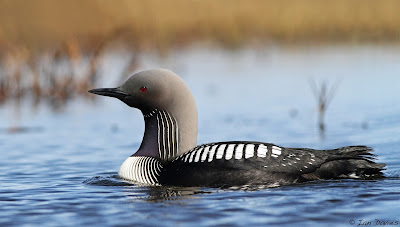Pacific Loon

Identification:
Pale gray crown and nape; black-and-white checkered back; iridescent throat patch can appear purple, green, or black. IN WINTER: Straight sharp border between the light and dark areas of the neck; eye is in the black cap.Some individuals have a thin dark line under the chin. IMM: Similar to winter adult, but with whitish scaling on back. IMM. plumage kept 1 year. >> The rare Arctic Loon, G.arctica, is similar but larger and breeds in western Alaska.
Nesting:
Platform nest of stems, roots, and mud, placed near the water's edge. Eggs: 1-2, brown with dark marks: I: 23-25 days; F: 60-65 days, precocial; B: 1.
Feeding:
Feeds by diving underwater and pursuing prey such as fish, crustaceans, and frogs.
Other Behavior:
One of the most numerous loons off the Pacific Coast, often feeding in flocks of hundreds or thousands along the coastline. The most commonly seen loon on winter pelagic trips in the West. It is rare, but regularly occurring, off the East Coast.
Habitat:
Summers on tundra lakes; winters along coast.
Voice:
Generally quiet in winter; summer calls include a sharp call like "kwao" and a wail that rises in pitch.
-I hope that you can share your opinion if the article is good or not, and following us on google+ to know anything is news

0 التعليقات :
Post a Comment